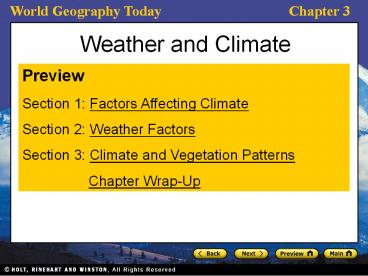Weather and Climate - PowerPoint PPT Presentation
Title:
Weather and Climate
Description:
Weather and Climate Preview Section 1: Factors Affecting Climate Section 2: Weather Factors Section 3: Climate and Vegetation Patterns Chapter Wrap-Up – PowerPoint PPT presentation
Number of Views:151
Avg rating:3.0/5.0
Title: Weather and Climate
1
Weather and Climate
- Preview
- Section 1 Factors Affecting Climate
- Section 2 Weather Factors
- Section 3 Climate and Vegetation Patterns
- Chapter Wrap-Up
2
Section 1 Factors Affecting Climate
- Read to Discover
- How does the Sun affect Earths atmosphere?
- How does atmospheric pressure distribute energy
around the globe? - How do global wind belts affect weather and
climate? - How do the oceans affect weather and climate?
3
Section 1 Factors Affecting Climate
Question By which processes does the Sun
interact with Earths atmosphere?
4
Section 1 Factors Affecting Climate
The Suns Effect on Earth
The greenhouse effect helps keep the planet warm.
5
Section 1 Factors Affecting Climate
Atmospheric Pressure
- Low-pressure zones are caused by warm air, which
expands and rises. - High-pressure zones are caused by cold air, which
is dense and sinks. - Pressure differences cause airflow and energy
distribution around the globe. - Warm air moves through the upper atmosphere until
the air cools and falls cold air sinks toward
Earths surface and then heats up and rises.
6
Section 1 Factors Affecting Climate
Global Winds
- Pressure differences cause wind.
- Winds move heat and cold across Earths surface.
- Prevailing winds blow from the same direction
most of the time, causing similar weather. - A front occurs when two air masses of widely
different temperatures or moisture levels meet.
7
Section 1 Factors Affecting Climate
Oceans
- Water heats and cools more slowly than land,
making coastal areas milder than inland areas. - Ocean currents move heat between the tropics and
polar regions, helping to maintain Earths energy
balance.
8
Section 2 Weather Factors
- Read to Discover
- What are the common forms of precipitation, and
how are they formed? - How do mountains and elevation affect weather and
climate? - What are the different types of storms, and how
do they form?
9
Section 2 Weather Factors
Question What are the steps in the formation of
precipitation, and what are the four common
types of precipitation?
10
Section 2 Weather Factors
11
Section 2 Weather Factors
Forms of Precipitation
- RainLiquid formed through condensation of water
vapor - SnowIce crystals formed in clouds
- SleetRain that freezes as it falls
- HailChunks of ice formed in storm clouds
12
Section 2 Weather Factors
Question How do mountains and elevation affect
weather and climate?
13
Section 2 Weather Factors
- Increase in elevation causes drop in temperature.
- Mountains cause orographic effect Moist air
meets a barrier and is pushed upward, causing
cooling, condensation, and precipitation. - Mountainside facing wind is the windward, wetter
side side facing away from wind is the leeward,
drier side, called the rain shadow.
14
Section 2 Weather Factors
Types of Storms
- Middle-latitude storms form when cold, dry polar
air mixes with moist, warm tropical air. Examples
include thunderstorms and tornadoes. - Tropical storms are usually smaller and lack
fronts. Examples include hurricanes and typhoons.
15
Section 3 Climate and Vegetation Patterns
- Read to Discover
- How do the two tropical climates differ?
- What conditions are common in dry climates?
- What climates are found in the middle latitudes?
- What characterizes high-latitude and highland
climates?
16
Section 3 Climate and Vegetation Patterns
Question What are the characteristics of
tropical humid and tropical wet and dry climates?
17
Section 3 Climate and Vegetation Patterns
Tropical Wet and Dry Climates
Tropical Humid Climate
- Close to equator
- Warm temperatures
- Rainfall all year
- Receives Suns rays directly all year
- Rising warm air
- Rain forests
- Monsoons
- North and south of tropical humid
- Caused by seasonal change in this
area - Alternating wet and dry seasons
- Savannas
18
Section 3 Climate and Vegetation Patterns
Dry Climate Areas
- Generally centered about 30 degrees north and
south of equator - Subtropical high-pressure zone causes sinking dry
air, with little rain. - Winters may be very cold, summers very hot.
- Hardy plants and animals
19
Section 3 Climate and Vegetation Patterns
Middle-Latitude Climates
- MediterraneanLong, dry summers and mild winters
scrub woodland vegetation - Humid SubtropicalHot, humid summers and mild
winters temperate forests - Marine West CoastMild all year may support
dense forests - Humid ContinentalVariable, with four seasons
enough rain to support forests
20
Section 3 Climate and Vegetation Patterns
High-Latitude and Highland Climates
- SubarcticLong, cold winters and short, warm
summers vast evergreen forests - TundraLong winters, with permafrost low shrubs,
lichens, mosses, ferns - Ice CapPolar climates few land plants or
animals - HighlandVaries by elevation, with low elevations
relatively mild and high elevations similar to
ice cap
21
Chapter Wrap-Up Understanding the Main Ideas
- How does latitude relate to climate?
- How do atmospheric pressure zones and ocean
currents affect Earths energy balance? - On a global scale, where is precipitation most
common? - What effects can hurricanes have on local
environments? - Where will you find climates that are generally
warm and wet all year? What creates dry weather
conditions in arid regions?































